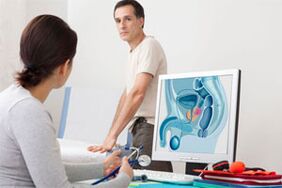Prostatitis is an inflammation of the prostate gland called prostate. Prostate iron is a secondary part of male reproductive organs. Located under the bladder around his neck. The fact is that the urethra passes through the prostate, that is, the prostate is located around the urinary tube. As a result, as the prostate enlarges, a canal is squeezed, which shows urine, which interferes with the passage of urine.

In men over 35, the prostate is often increased. This is a typical phenomenon. Most of the diseases in men over 50 are just a consequence of a disorder of the genius system, that is, as a result of inflammation of the prostate gland. It must be remembered that the more simple iron, the more urine it will be blocked, thus more poisoned by this urine.
The causes of prostatitis are distinguished by the following:
The signs of acute prostatitis are an increase in body temperature and rapid urination, which is accompanied by raw and low pressure. In addition, the signs of prostatitis are the burning of the perineum and the pain in the rectum during bowel movements. At the stage of purulent inflammation, the likely spontaneous opening of the abscess and the leakage of pus from the urethra or rectum.
A sign of chronic prostatitis forests in urethra and perineum, release of pus at the end of the act of bowel movements or urination, increased fatigue and irritability of the body.
It is very dangerous with prostatitis of difficulty urinating, which in the absence of timely treatment can lead to acute retention of urine.
If we talk about even specialized manifestations, then in most cases patients notice a transparent or sometimes purulent discharge from the urethra, especially noticeable in the morning and the presence of white flakes and threads in the urine.

A sharp shape. Like many diseases, prostatitis is divided into acute and chronic. The common symptoms are characteristic of the acute form of the disease.
Chronic form. Unlike acute form, the chronic form of prostatitis has an asymptomatic course and is latent (ie without pronounced characteristic characteristics). The clinical picture is often erased, with mild symptoms, patients do not pay proper detection of appropriate attention and do not consider seeking medical help, confusing symptoms of prostatitis with prostate adenoma, which is extremely dangerous. The principles for the treatment of these diseases are completely different, as well as possible complications with unwanted consequences.
Often the worsening of overall well -being, problems with the potency and nervous disorders of men are written off by fatigue and lack of rest, that is, a person simply does not want to realize that he is sick and needs treatment. An important role in the timely detection of this disease is annually preventive examinations, which allow for a diagnosis at the most in the most stages.
The chronic form of prostate inflammation is expressed in mild pain in the perineum, in the pubic region and the groin that quickly passes. As a rule, the duration of sexual intercourse changes both the extension and the vice versa and the brightness of sexual sensations. Disposes appear from the urethra, especially in the morning or white flakes are visible in the urine with the naked eye.
Identification of prostatitis is engaged with a urologist. It diagnoses the fact of prostate damage. Based on the symptoms of the disease, the doctor can now determine the stage of its development during the first trick. Be sure to be prescribed the ultrasound of the person of the prostate.
Possible diagnostic measures:
If the data obtained is not sufficient to diagnose, then the patient is placed in a hospital and under his or her conditions a urodynamic examination is performed.
Cystoscopy is a method of diagnosing prostate diseases during which the doctor can perform some therapeutic manipulations. However, they rarely resort to it.

Although such a disease as prostatitis is long known and is widely used among men of different ages, it is difficult enough to treat.
While with the therapy with acute prostatitis of difficulties, as a rule, there is no, chronic prostatitis of the correction is not always busy. In addition, exactly how it is necessary to treat chronic inflammation of the prostate gland in scientists have many perspectives.
However, the following points have no disagreements:
Treatment of acute bacterial prostatitis directly depends on how much the symptoms of the disease are expressed. Sometimes the patient's condition is extremely serious, which often happens when the body is intoxicated.
The disease manifests itself acute, body temperature rises sharply, it seems chills, pelvic pain, at the lower back, perineum. It is possible to join nausea and vomiting, violation of the bladder emptying process with acute pain, burning sensation and more. This condition is dangerous with its complications. It is possible to join the bacterial infection, the development of an abscess of the prostate gland. Most often, complications arise against the background of existing chronic diseases, for example, in the presence of diabetes.
If the disease is acute, the man should be hospitalized in the hospital, in the urological profile ward. If this is not possible, then the patient is determined in the general surgical department.
There is a general treatment tactics to conduct patients with acute prostatitis:
Surgery is necessary if the possibility of independent emptying of the bladder is completely absent or an abscess of the prostate is formed.
The use of antibiotics to treat bacterial prostatitis is a must. If the disease starts acute, there are symptoms of intoxication, then antibacterial drugs are prescribed as quickly as possible, wait for the results of the bacterial flora tests in this case are inappropriate and dangerous.
Chronic prostatitis therapy depends directly on what stage the disease is. If the disease is exacerbated, then the treatment is similar to treatment with acute bacterial prostatitis.
Suggest the following patient tactics:

Prostatitis is a serious disease that is associated with a number of complications. Sometimes you manage to get rid of them, and sometimes they are irreversible. Therefore, with the first manifestations of the disease, you should contact a specialist.
So, with prostatitis, testes and appendages can be inflamed. If you do not eliminate the pathological reaction of the body over time, that is, the likelihood of developing an abscess in which the organ will begin to rot.
Measures for the prevention of chronic prostatitis are primarily aimed at preventing its exacerbation. If this has already happened, the inflammation should be removed as soon as possible.
In order to minimize the risk of relapse, you must completely refuse or minimize the effect of the following negative factors:
There are also some recommendations that will enhance the health of men:





































